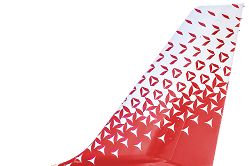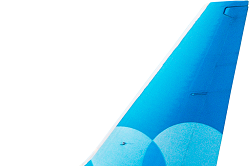Aircraft Fleet
Fleet development strategy
Aeroflot Group’s fleet development strategy is focused on:
- operating a highly unified aircraft fleet (limited number of aircraft types in each segment)
- operating a young fleet
- improving the average seat capacity and efficiency of aircraft
- increasing the share of modern Russian-built aircraft used in operations.
| 2014 | 2018 | |
 Narrow-body (regional) |
|
|
 Narrow-body (medium-haul) |
|
|
 Wide-body |
|
|
| 11 types of aircraft | 8 types of aircraft |
Over the last years, the Group has been consistently refreshing its aircraft fleet, bringing the average age of the fleet in operation down from 7.0 years in 2014 to 6.3 years in 2018. Aeroflot airline’s fleet is one of the youngest in the world, with an average age of 4.2 years as at 2018 year end.
To improve its operational performance and cut costs, the Group has been working to unify its aircraft fleet in the past several years. From 2014 to 2018, the types of aircraft in operation reduced from 11 to 8.
 Note. Data for 2017 and 2018 exclude An-24 and An-148 aircraft that
were not operated by the Group during the periods indicated
Note. Data for 2017 and 2018 exclude An-24 and An-148 aircraft that
were not operated by the Group during the periods indicated

Aeroflot Group enhances its fleet in line with specific business models and route networks of each airline.
Aeroflot airline’s fleet comprises several types of aircraft produced by major manufacturers and focuses on addressing the needs of both the mass-market and premium segments. Aircraft offer two to three travel classes to serve passengers in flight. As seat capacity in comparable narrowbody aircraft is different between Business and Economy classes, we can change the Business to Economy ratio for more effective, demand-driven capacity management.
Rossiya airline operates Airbus and Boeing narrowbody aircraft primarily on scheduled routes, as well as Boeing wide-body aircraft on leisure flights (to destinations under the charter programme and resorts of the Black Sea) and flights to cities in the Far East.
The aircraft fleet of the low-cost carrier Pobeda comprises one aircraft type, Boeing 737-800, with a single cabin configuration. Aurora airline operates Airbus A319 narrow-body aircraft on scheduled routes and turboprops for local flights.
 |
 |
 |
 |
| Manufacturer | |||
|
|
|
|
5 types |
4 types |
1 type |
3 types |
| Narrow-body | |||
|
|
|
|
| Wide-body | |||
|
|
||

Aeroflot’s History
In the 1960s, the reliable, fuel-efficient, and comfortable Il-18 became Aeroflot’s most popular aircraft. As many as up to 24 Il-18 aircraft flights were departing daily from Moscow to Krasnoyarsk alone in the summer of 1969, with a total of up to 50 Il-18 aircraft based at Krasnoyarsk airport at the time.
In the 1970s and 1980s, medium-haul jetliners Tu-134 and Tu 154 became the mainstay of Aeroflot’s fleet.
Aeroflot Group’s aircraft fleet1
During 2018, Aeroflot Group was actively expanding its operating capacity with 55 new aircraft added to the fleet. Over the same period, Aeroflot Group phased out 14 aircraft: thus, the net fleet increase amounted to 41 aircraft.
As at 2018 year-end, Aeroflot Group operated a fleet of 366 aircraft, with narrow-body mediumhaul aircraft comprising the bulk of the fleet (66.7%), narrow-body aircraft for regional flights representing 17.5% of the fleet, and wide-body aircraft for long-haul flights – 15.8%.


| Type of aircraft | As at 31 December 2017 | Change 2018 | As at 31 December 2018 | |
|---|---|---|---|---|
| phased in | phased out | |||
| Airbus A330-200 | 5 | – | – | 5 |
| Airbus A330-300 | 17 | – | – | 17 |
| Boeing 777-300 | 5 | – | – | 5 |
| Boeing 777-300ER | 16 | 6 | – | 22 |
| Boeing 747-400 | 9 | – | – | 9 |
| Wide-body | 52 | 6 | – | 58 |
| Airbus А319 | 36 | – | 1 | 35 |
| Airbus А320 | 80 | 11 | 6 | 85 |
| Airbus А321 | 38 | 5 | 6 | 37 |
| Boeing 737-800 | 68 | 20 | 1 | 87 |
| Narrow-body (medium-haul) | 222 | 36 | 14 | 244 |
| DHC-6-400 | 3 | – | – | 3 |
| DHC-8-200 | 2 | – | – | 2 |
| DHC-8-300 | 4 | – | – | 4 |
| DHC-8-400 | 5 | – | – | 5 |
| Superjet 100 | 37 | 13 | – | 50 |
| Narrow-body (regional) | 51 | 13 | – | 64 |
| Total | 325 | 55 | 14 | 366 |
Aeroflot airline’s aircraft fleet
As at the end of 2018, the flagship airline of Aeroflot Group had 253 aircraft, including 164 narrow-body medium-haul aircraft, 50 regional narrow-body aircraft, and 39 wide-body aircraft.
Airbus A320 family, Boeing 737-800, SSJ100, and Boeing 777-300ER aircraft were added to Aeroflot airline’s fleet in 2018. The net fleet increase amounted to 29 aircraft.

+29 net increase in aircraft fleet

| Type of aircraft | As at 31 December 2017 | As at 31 December 2018 | Change |
|---|---|---|---|
| Airbus A330-200 | 5 | 5 | – |
| Airbus A330-300 | 17 | 17 | – |
| Boeing 777-300ER | 16 | 17 | 1 |
| Wide-body | 38 | 39 | 1 |
| Airbus A320 | 75 | 80 | 5 |
| Airbus A321 | 38 | 37 | –1 |
| Boeing 737-800 | 36 | 47 | 11 |
| Narrow-body (medium-haul) | 149 | 164 | 15 |
| Superjet 100 | 37 | 50 | 13 |
| Narrow-body (regional) | 37 | 50 | 13 |
| Total | 224 | 253 | 29 |
Subsidiaries’ aircraft fleet
Five Boeing 777-300ERs, one Boeing 737-800, and one Airbus A320 were added to Rossiya airline’s fleet in 2018, resulting in a net fleet increase of four aircraft. As at 2018 year-end, Rossiya operated a fleet of 65 aircraft.
In 2018, Pobeda airline received eight new narrowbody Boeing 737-800 aircraft, expanding its total fleet of Boeing 737-800s to 24 aircraft as at the end of 2018.
Aurora airline’s fleet remained flat year-on-year at 24 aircraft, including narrow-body medium-haul Airbus 319s, as well as DHC-8 and DHC-6 feeder (narrow-body turboprop) aircraft for local flights.

+4 net increase in aircraft fleet

+8 net increase in aircraft fleet
| Type of aircraft | As at 31 December 2017 | As at 31 December 2018 | Change |
|---|---|---|---|
| Airbus A319 | 26 | 25 | (1) |
| Airbus A320 | 5 | 5 | – |
| Boeing 737-800 | 16 | 16 | – |
| Boeing 747 | 9 | 9 | – |
| Boeing 777-300 | 5 | 5 | – |
| Boeing 777-300ER | – | 5 | 5 |
| Rossiya airline | 61 | 65 | 4 |
| Airbus A319 | 10 | 10 | – |
| DHC-6-400 | 3 | 3 | – |
| DHC-8-200 | 2 | 2 | – |
| DHC-8-300 | 4 | 4 | – |
| DHC-8-400 | 5 | 5 | – |
| Aurora airline | 24 | 24 | – |
| Boeing 737-800 | 16 | 24 | 8 |
| Pobeda airline | 16 | 24 | 8 |
| Total | 101 | 113 | 12 |
Fleet development plans
PJSC Aeroflot continues to be the largest operator of Russian high-tech aircraft. As part of this major role, over the years, Aeroflot has helped to commission and improve all Russian aircraft models. It is Aeroflot’s top priority to act in the interests of the Russian aviation industry and the country in general. The Company plans to operate 200 Russian-built aircraft by the end of 2026.
- PJSC Aeroflot and Rostec signed a contract in 2018 for delivery of 50 next-generation passenger aircraft, MC-21. The deal has made Aeroflot the largest operator of MC-21, Russia’s latest medium-range aircraft. The deal was approved by the Annual General Meeting of Shareholders.
- Aeroflot took delivery of 50th Russianbuilt SSJ100 aircraft and signed a contract with United Aircraft Corporation for the delivery of 100 more SSJ100s between 2019 and 2026. The final contract will be signed once corporate approvals are obtained in accordance with Russian laws.

In line with its approved the Strategy 2023, Aeroflot Group also plans to expand its fleet of wide-body aircraft, a prerequisite for growing international transfer traffic. A contract has been signed for the delivery of 22 modern Airbus A350 airliners to gradually replace the A330 aircraft currently in operation. The first deliveries are expected in 2020.
Flight hours
Aeroflot Group maintains high fleet utilisation efficiency. Due to the expansion of Aeroflot Group operations in 2018, flight hours increased by 11.3% year-on-year to 1,124 thousand hours. Aeroflot airline posted a 10.8% increase to 779 thousand hours.
Aeroflot Group’s flight hours per aircraft in operation per day averaged at 8.9 vs 9.1 in the previous year. The decline was driven by substantial fleet additions throughout the year, which required some time to maximise the utilisation efficiency. Aeroflot airline’s flight hours per aircraft in operation per day also averaged 8.9

 Note: The number of aircraft in operation in the reporting year is
calculated as the average of the number of aircraft as at the start and
the end of the period.
Note: The number of aircraft in operation in the reporting year is
calculated as the average of the number of aircraft as at the start and
the end of the period.
Fuel efficiency
In 2018, specific fuel consumption across Aeroflot Group decreased by 1.8 grams, or 0.7%, year-onyear to 274.5 grams per tonne-kilometre (TKM). Specific fuel consumption for Aeroflot airline increased by 6.0 grams, or 2.1%, to 283.5 g/TKM. At the same time, specific fuel consumption per passenger carried was reduced for Aeroflot Group from 22.8 to 22.5 grams per available seat-kilometre (g/ASK) while for Aeroflot airline the indicator remained flat at 23.0 g/ASK.
High fuel efficiency is an important benefit of the young aircraft fleet. Operating a young aircraft fleet also helps reduce the environmental footprint and slash CO2 and NOХ emissions into the atmosphere.



